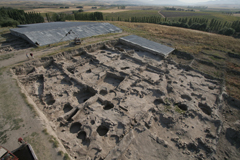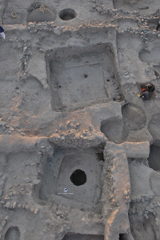- Excavation and General Survey >
- Kaman-Kalehöyük >
- 24th Excavation
Kaman-Kalehöyük
Dr. Sachihiro Omura Director, JIAA
24th Excavation and Survey at Kaman-Kalehöyük (2009)
Objective of survey
The 24th excavation and survey at Kaman-Kalehöyük was conducted starting on Monday, 29th June through to 28th August (Picture 1). The objective of excavation and survey at Kaman- Kalehöyük is to “compile cultural stratigraphy” in the North Trench and to “grasp and draw the settlements of each cultural layer” in the South trench. In the North Trench, made excavation and survey at the sectors XXXV and XXXVI which were set last year. In these excavation sectors, we also try to identify architectural remains, which were excavated east of these sectors: the IIIa layer – the Hittite Empire Period, the IIIb layer – the Old Hittite Kingdom Period and the IIIc layer – the Assyrian Colony Period.

Picture 1: Overview of the North and the South Trenches at time of finish of the excavation in this year.
From the South West of Kaman-Kalehöyük.
Remains in the North Trench
This season we continued survey removing the architectural remains of the 1st layer of which survey was done last year mainly in sector XXXV. In the 1st layer in sector XXXVI, over 10 Islamic dug tombs were found last year and this year two human bones were found in sector XXXVI. Observing these findings, there are obvious differences from the Islamic burial style found in sector XXXV and they are likely to belong to the IIa layer.
Remains in the South Trench

Picture 2: Overview of the South Trench
at time of finish of the excavation in this year.
Sector XXXIV (top) and sector LVII (bottom).
In last season excavation and survey in the IIc layer, in other words architectural remains of the 8th B.C. were conducted. The objective of this survey was to find any influences are identified in culture of the IIc layer from the IId layer which is just beneath the IIc layer. There being revealed that there are almost 3 layers of architectures in IIc layer, and further close survey on those architectural remains and partial removal of them were conducted in this season. There was a new development, when removed floor of the architectural remains which is over 1m deep half burial structure and to be the era of the 1st architectural layer of IIc layer. In R142 of sector LVII and sector R138 of XXXIV, affiliate floor to those architectural remains was found when the floor was removed. There also were something like benches surrounding the architectural remains. There found holes of columns in equal space, which shows similarity between the methods of architectural technique in IIc layer and IId layer (Picture 2).
When the architectural remains of IIc layer were removed in three excavation sectors LVI to LVIII, considered to be architectural remains of IId layer were found. The findings in architectural remains this time have some peculiar characteristics. One is it is half buried structure and stone wall is stuck to a surface scraped slightly. Two is there found many holes of column. Three is the corners of the rooms in the remains have rounded corners. Adding to them strong fire burnt them. The painted earthenware found from these remains are mainly wave figure or geometrical figure which are different from earthenware found in IIc layer in their style, however, there are certain similarities between architectural styles of these layers. There has to be further survey on this matter, but it is considered that the culture of IIc layer is in the same stream of IIc layer culture.
Remains

Picture 3: Painted earthenware found in the South trench this year.
Most of remains excavated this year are mainly from the 1st millennium B.C. There found many painted earthenware, bronze wares and iron wares in IIc layer and IId layer. It is considered that the painted earthenware found in IIc layer and IId layer are to be key to clarify the culture of so called “Dark Age” being said in Anatolian Archaeology.
Acknowledgements
The excavation and survey in Kaman-Kalehöyük has been supported by many of supporting bodies by ways of subsidies and aid money. We are grateful for all such supports extended to us and the following are names of bodies subsidized in 2009.
- Japan Keirin Association

- The Sumitomo Foundation
- Seki Memorial Foundation for the Promotion of Science and Technology
- Foundation for Cultural Heritage and Art Research